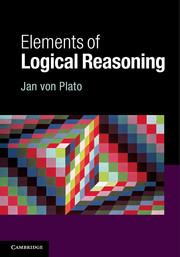Book contents
- Frontmatter
- Contents
- Preface
- PART I First steps in logical reasoning
- 1 Starting points
- 2 Rules of proof
- 3 Natural deduction
- 4 Proof search
- 5 Classical natural deduction
- 6 Proof search in classical logic
- 7 The semantics of propositional logic
- Part II Logical reasoning with the quantifiers
- Part III Beyond pure logic
- Part IV Complementary topics
- Suggestions for the use of this book
- Further reading
- Bibliography
- Index of names
- Index of subjects
4 - Proof search
Published online by Cambridge University Press: 05 June 2014
- Frontmatter
- Contents
- Preface
- PART I First steps in logical reasoning
- 1 Starting points
- 2 Rules of proof
- 3 Natural deduction
- 4 Proof search
- 5 Classical natural deduction
- 6 Proof search in classical logic
- 7 The semantics of propositional logic
- Part II Logical reasoning with the quantifiers
- Part III Beyond pure logic
- Part IV Complementary topics
- Suggestions for the use of this book
- Further reading
- Bibliography
- Index of names
- Index of subjects
Summary
The construction of derivations in Gentzen's tree form is awkward: One would have to know, more or less, how the final tree has to look before one can start. So one looks at the assumptions, and one looks at the conclusion, and one tries to figure a way from the former to the latter. The good aspects of the tree form include that once you have the tree, its structure is transparent.
We shall modify a bit natural deduction, to get a logical calculus that supports proof search better. The starting point is the change in Section 3.4 in which all E-rules were written with an arbitrary conclusion. Consider any formula C in a derivation tree. The assumptions it depends on can be listed, and let them be A1,…, An. If you take the part of the tree that is determined by the chosen formula C, you geta subderivation of the original derivation. To be precise, to get a correct derivation tree you have to delete the labels from above those assumptions that have not been closed at the stage in which formula C is concluded. The subderivation establishes a derivability relation, namely A1,…, An ⊢ C.
It will be convenient to have a name for the thing a derivability relation establishes: Expressions of the form A1,…, An ⊢ C are called sequents. The name stems from the arrangement of formulas in a sequence in the antecedent, left part of a sequent.
- Type
- Chapter
- Information
- Elements of Logical Reasoning , pp. 64 - 79Publisher: Cambridge University PressPrint publication year: 2014



